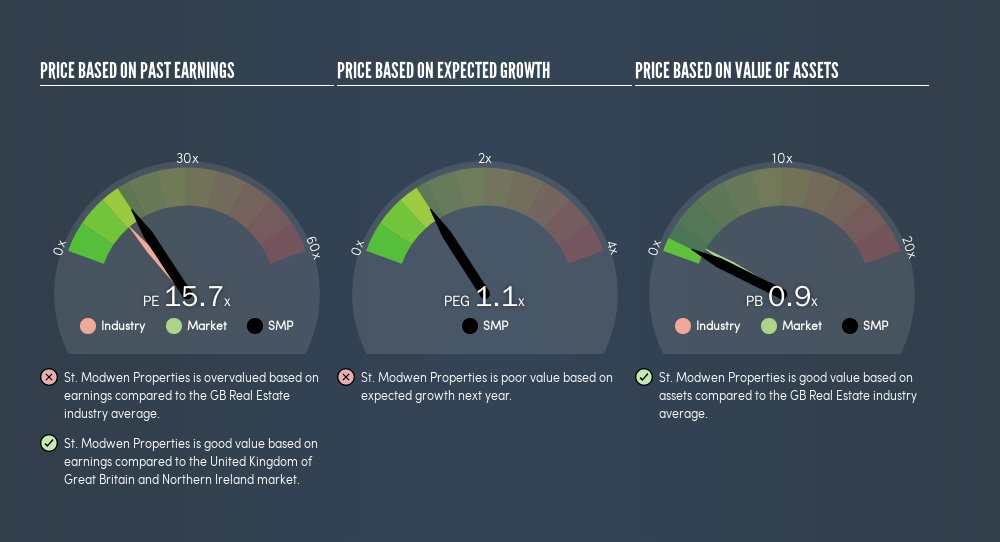
Want to participate in a short research study? Help shape the future of investing tools and you could win a $250 gift card!
This article is written for those who want to get better at using price to earnings ratios (P/E ratios). We'll show how you can use St. Modwen Properties PLC's (LON:SMP) P/E ratio to inform your assessment of the investment opportunity. Based on the last twelve months, St. Modwen Properties's P/E ratio is 15.74. That means that at current prices, buyers pay £15.74 for every £1 in trailing yearly profits.
See our latest analysis for St. Modwen Properties
How Do You Calculate A P/E Ratio?
The formula for P/E is:
Price to Earnings Ratio = Share Price ÷ Earnings per Share (EPS)
Or for St. Modwen Properties:
P/E of 15.74 = £4.27 ÷ £0.27 (Based on the trailing twelve months to November 2018.)
Is A High Price-to-Earnings Ratio Good?
A higher P/E ratio implies that investors pay a higher price for the earning power of the business. That isn't a good or a bad thing on its own, but a high P/E means that buyers have a higher opinion of the business's prospects, relative to stocks with a lower P/E.
How Growth Rates Impact P/E Ratios
If earnings fall then in the future the 'E' will be lower. Therefore, even if you pay a low multiple of earnings now, that multiple will become higher in the future. Then, a higher P/E might scare off shareholders, pushing the share price down.
St. Modwen Properties had pretty flat EPS growth in the last year. And over the longer term (5 years) earnings per share have decreased 4.1% annually. So we might expect a relatively low P/E.
Does St. Modwen Properties Have A Relatively High Or Low P/E For Its Industry?
We can get an indication of market expectations by looking at the P/E ratio. As you can see below, St. Modwen Properties has a higher P/E than the average company (12.6) in the real estate industry.

Its relatively high P/E ratio indicates that St. Modwen Properties shareholders think it will perform better than other companies in its industry classification. Clearly the market expects growth, but it isn't guaranteed. So investors should always consider the P/E ratio alongside other factors, such as whether company directors have been buying shares.
Remember: P/E Ratios Don't Consider The Balance Sheet
The 'Price' in P/E reflects the market capitalization of the company. So it won't reflect the advantage of cash, or disadvantage of debt. In theory, a company can lower its future P/E ratio by using cash or debt to invest in growth.
Such expenditure might be good or bad, in the long term, but the point here is that the balance sheet is not reflected by this ratio.
Is Debt Impacting St. Modwen Properties's P/E?
Net debt is 29% of St. Modwen Properties's market cap. You'd want to be aware of this fact, but it doesn't bother us.
The Bottom Line On St. Modwen Properties's P/E Ratio
St. Modwen Properties's P/E is 15.7 which is about average (16) in the GB market. When you consider the modest EPS growth last year (along with some debt), it seems the market thinks the growth is sustainable.
Investors have an opportunity when market expectations about a stock are wrong. If it is underestimating a company, investors can make money by buying and holding the shares until the market corrects itself. So this free visualization of the analyst consensus on future earnings could help you make the right decision about whether to buy, sell, or hold.
You might be able to find a better buy than St. Modwen Properties. If you want a selection of possible winners, check out this free list of interesting companies that trade on a P/E below 20 (but have proven they can grow earnings).
We aim to bring you long-term focused research analysis driven by fundamental data. Note that our analysis may not factor in the latest price-sensitive company announcements or qualitative material.
If you spot an error that warrants correction, please contact the editor at editorial-team@simplywallst.com. This article by Simply Wall St is general in nature. It does not constitute a recommendation to buy or sell any stock, and does not take account of your objectives, or your financial situation. Simply Wall St has no position in the stocks mentioned. Thank you for reading.
Market Insights
Community Narratives




